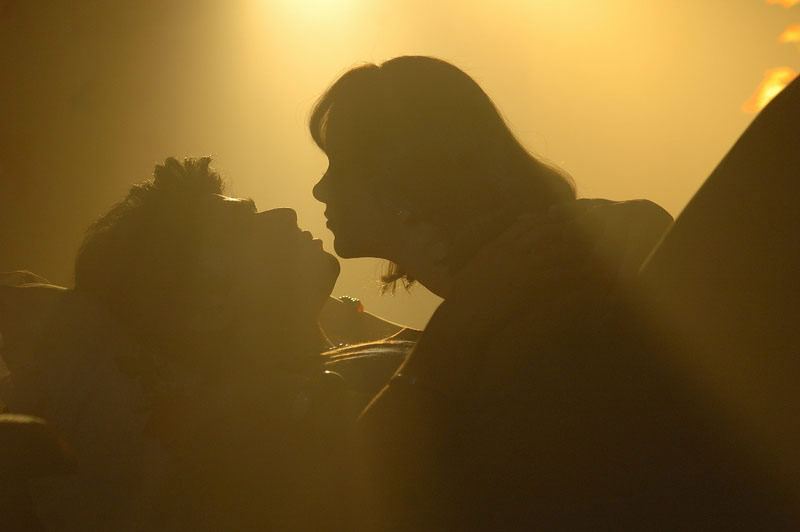Sex in Space & Other Interstellar Travel Challenges Revealed

ORLANDO, Fla. — Building a spaceship to visit another star is hard enough, but keeping the humans onboard alive for the ride may be even harder, space experts said Friday (Sept. 30) in a symposium dedicated to interstellar travel.
A trip to even one of the closest stars would take decades and possibly hundreds of years, likely spanning multiple generations. But scientists aren't even sure humans can procreate safely in the microgravity of space.
"It is still unknown, if you want kids and you want reproduction, what gravity has to do with successful development," MIT researcher Dan Buckland said here at the 100-Year Starship Symposium, a conference sponsored by the Defense Advanced Research Projects Agency (DARPA) to discuss technologies and strategies needed for planning a mission to another star. [Gallery: Visions of Future Human Spaceflight]
So far, humans haven't managed to send a probe beyond even our own solar system, let alone to the nearest star more than 4 light-years away. A light-year, the distance light travels in a single year, is about 6 trillion miles (10 trillion kilometers).
"The distances to the stars at vast," said biologist Athena Andreadis of the University of Massachusetts Medical School. "Large starships will have to be self-sustainable. We don't have such technology yet."
Unless scientists can invent a practical method of simulating gravity on a spacecraft, an interstellar journey would be spent in weightlessness. Over time, microgravity ravages the body, decreasing blood volume, atrophying muscles, diminishing bone mineral content and impairing vision.
Breaking space news, the latest updates on rocket launches, skywatching events and more!
Sex in space and other worries
The effects on a developing fetus would likely be even more severe, perhaps disrupting normal embryonic development and even neurological functioning. A baby's body and bones may develop differently in weightlessness.
And then there's birth to think about.
"Giving birth in zero gravity is going to be hell because gravity helps you" on the ground, Andreadis told SPACE.com. "You rely on the weight of the baby."
And that's if would-be parents can even get that far.
"Sex is very difficult in zero gravity, apparently, because you have no traction and you keep bumping against the walls," Andreadis said. "Think about it: you have no friction, you have no resistance."
Ultimately, even if human babies can successfully be conceived and born in space, multigenerational space travel comes with a host of other difficulties. In addition to the ill-effects of microgravity on the body, people on such a journey could fall prey to disease, and the psychological effects of being stuck onboard a vehicle in the vacuum of space could take their toll.
"Something will come up that we simply haven't thought about," Andreadis said. "We have to be prepared for casualties."
Getting there is only half the challenge
And arriving at the destination — another star, hopefully one with a habitable planet that humans can colonize — doesn't end the difficulties.
Even habitable planets are unlikely to be identical to Earth, so we will likely have to build an Earth-like biosphere within a dome to live in, or terraform the planet completely. Besides the ethical questions of whether it's right to radically alter another world, and potentially eradicate any microbial life on it, terraforming is a complex technological endeavor. [The Top 10 Star Trek Technologies]
"Not only are we bad at terraforming, but we don’t have the life span or the attention span to carry it through," Andreadis said. "Terraforming is a failure of the imagination. It's like people who take those expensive trips to Paris and eat at McDonald's."
A better option may be to genetically engineer people to withstand their newfound environment. Though that, of course, is quite complicated too, and could create a second species of humans that are so different from those back on Earth that the two groups wouldn't even be able to interbreed if they were reunited.
"We will have to grow up and do self-directed evolution, realizing that what comes out of the other end may not be human," Andreadis said. "If we stake our future among the stars, we must change for the journey and the destination."
You can follow SPACE.com senior writer Clara Moskowitz on Twitter @ClaraMoskowitz. Follow SPACE.com for the latest in space science and exploration news on Twitter @Spacedotcom and on Facebook.

Clara Moskowitz is a science and space writer who joined the Space.com team in 2008 and served as Assistant Managing Editor from 2011 to 2013. Clara has a bachelor's degree in astronomy and physics from Wesleyan University, and a graduate certificate in science writing from the University of California, Santa Cruz. She covers everything from astronomy to human spaceflight and once aced a NASTAR suborbital spaceflight training program for space missions. Clara is currently Associate Editor of Scientific American. To see her latest project is, follow Clara on Twitter.

